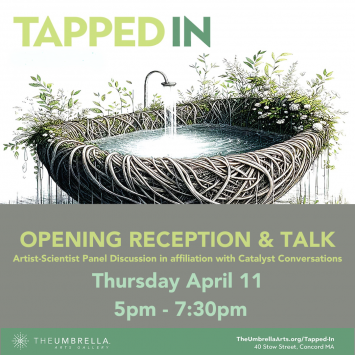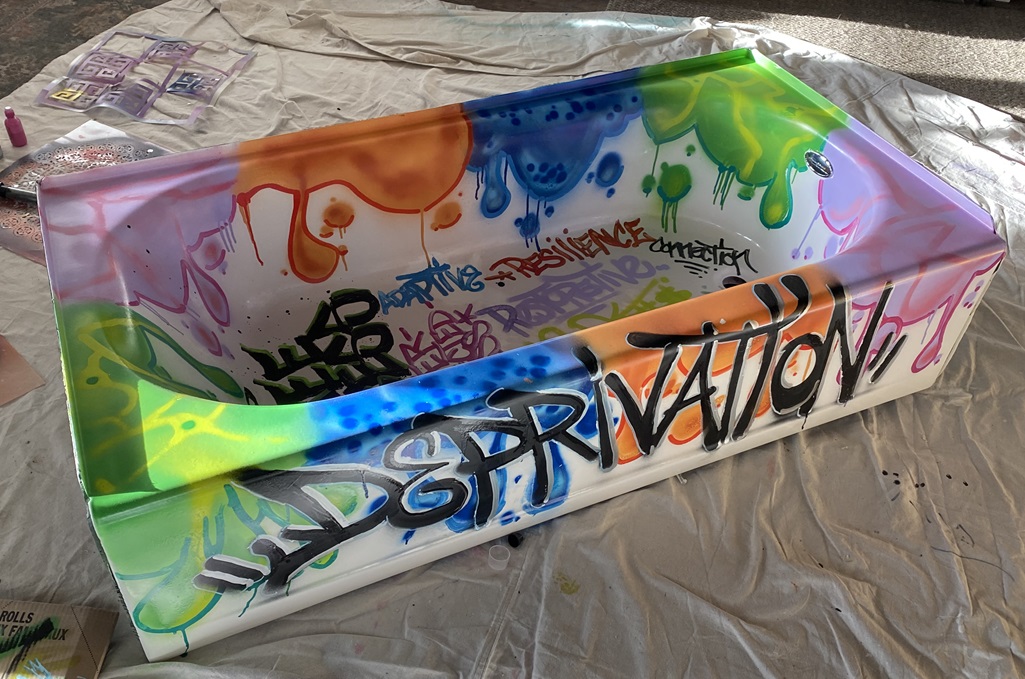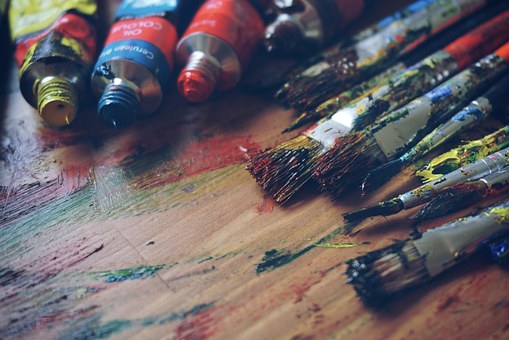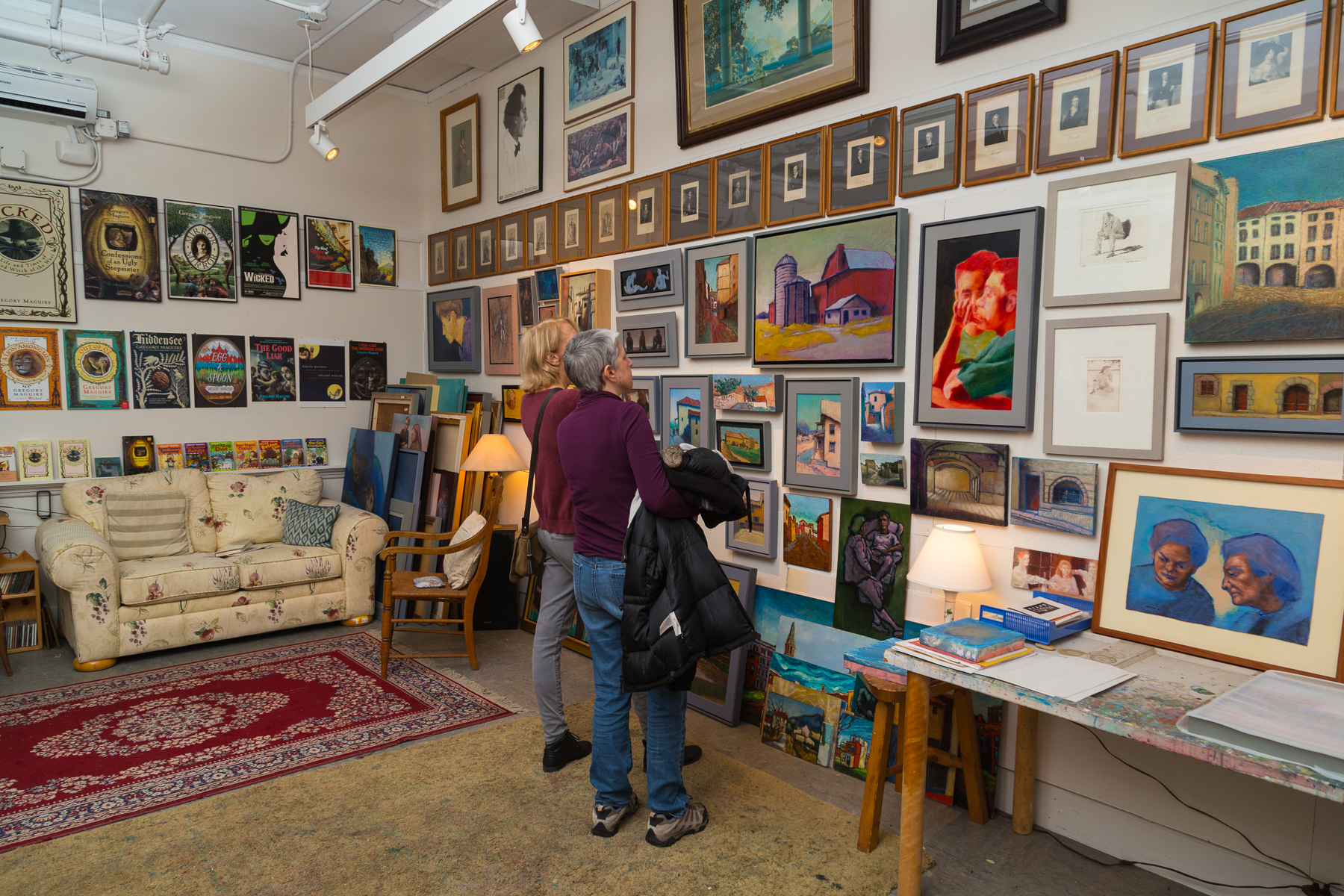Take 5 with Dr. Linda Booth Sweeney
April 11, 2024 by Stewart

Dr. Linda Booth Sweeney is a systems educator, author and advocate for healthier human systems. She is internationally recognized for her efforts to make systems thinking accessible to diverse audiences, including students, educators, policymakers, and business leaders. She has made significant contributions to promoting the use of metaphors like the bathtub model to enhance public comprehension of critical issues such as climate change. In her work, Linda uses storytelling, visualizations, mixed reality and interactive activities to engage learners and help them understand the complexities of the interconnected systems that shape our world. We asked her to share the concept behind the new Tapped In indoor/outdoor exhibition at The Umbrella (on view April 11 - June 8, 2024), which she co-curated with Visual Arts Manager Stephanie Marlin-Curiel.
What was the inspiration for TAPPED IN?
The inspiration for TAPPED IN is deeply personal for me. With the news filled with the impacts of climate change — extreme weather events, melting ice caps and so much more — I felt like a woman with my hair on fire. I had to ask myself, "What can I do? How can I engage? How can I meet this moment?" As a long-time art student at The Umbrella Arts Center, I wondered how I could move people to climate action through art? That's when I turned to the metaphor of the bathtub., Initially framed by MIT professor John Sterman, the bathtub explains in simple language the complex relationship between human activities, greenhouse gas emissions, and global warming.
I had learned about the bathtub when John was my dissertation advisor in grad school. He and I eventually collaborated on two seminal papers — "Bathtub Dynamics" and "Understanding Public Complacency About Climate Change". Back then (20 years ago!) I knew the bathtub could reach people across ages, from 8 to 98. I used it often with my own three kids and created a “Think Like a Bathtub” game in The Climate Change Playbook. Over the years, I witnessed its slow but steady traction as influential people like Bill Gates, Katharine Hayhoe Al Gore Senator John F Kerry Elizabeth Kolbert, Andrew Jones, Elizabeth Sawin, and National Geographic integrated it into their climate communications.
Thanks largely to the vision of Stephanie Marlin-Curiel, the Visual Arts Manager at The Umbrella Arts Center and others on its leadership team, here we are: co-curating the TAPPED IN installation matching ten artists with ten scientists looking to analyze and improve on the systems affecting our climate with large-scale solutions. Drawing inspiration from indigenous methodologies and an astrophysicist searching for other planets like earth, we aim to expand the conversation, build planetary awareness, and invoke the imagination. The goal: To open hearts and minds to move towards greater climate understanding and action.
Tell us about the Bathtub metaphor?
A lot of people want to make a difference when it comes to climate change. But what can one person do? Without a way to make sense of the complexity, it’s easy to feel disempowered and shut down. Other people think the best thing to do is “wait & see”. They assume that climate change can be fixed quickly. But, if you know how a bathtub works, you know better.
Before we started burning fossil fuels, what went into the atmosphere each year and what the earth and oceans absorbed were just about in balance. That means the carbon dioxide (CO2) people and animals gave off was taken in by trees and plants and the oceans. Scientists call these carbon sinks. About 200 years ago, we started to burn fossil fuels — like coal and oil and gas — to heat homes and power factories, cars and ships and more. A lot more carbon was released into the atmosphere. Here’s the problem: there was TOO MUCH carbon. In the U.S., about 20 tons of CO2 goes into the atmosphere for each person every year. With the carbon sinks full, the C02 has to go somewhere. So it ends up in the atmosphere.
Our atmosphere is like a big bathtub. The faucet is the amount of CO2 that is going into the atmosphere from our cars, homes and more. We call these CO2 emissions. The drain is the carbon sinks, like trees, plants, gardens and oceans. Imagine you’re in the bath, and twice as much water is coming into your tub than is going out. What do you think is going to happen to the water in the tub? If you said, “the water would go up,” you’re right. That’s what is happening with CO2 in the atmosphere today. Today we’re putting twice as much CO2 into the atmosphere than the carbon sinks can absorb. That extra carbon dioxide is building up in the atmosphere, and acting like a blanket that is slowly warming the Earth. That’s why when we talk about climate change, we call it global warming. As long as we pour CO2 into the atmosphere faster than it drains out, the amount of CO2 in the atmosphere will keep rising, and climate change will speed up.
As you walk around the TAPPED installation, you can explore a number of different ways to “turn down the faucet”, “improve the drain” and help improve both at the same time. For a great explanation of the Bathtub, see this 3 minute video narrated by youth from around the world created for COP26 in Scotland:
What’s most exciting about the opening?
So much is exciting about this installation! One is the convergence of worlds, art and science. Most of the artists had not heard of the scientists, and vice versa. Now some are visiting each other's studios and labs, engaging with each other's students, and celebrating and amplifying each other’s work, both art and science. I think the reciprocal relationships speak volumes about the power of interdisciplinary collaboration and the potential for creativity and innovation when different perspectives come together.
At the April 11th opening from 5-6pm, we’ll be celebrating the artists and scientists, and the community of climate action folks who will be able to connect and learn from each other. From 6-7:30pm, Stephanie Marlin-Curiel and I will moderate a panel discussion in affiliation with Catalyst Conversations in Cambridge, a series of intimate and provocative conversations between artists, scientists, and the public. Three artist-scientist pairs will talk about their collaborative process and we will hear more about Massachusetts’s climate goals and actions from MA Climate Chief Mellisa Hoffer and Senator Michael Barrett.
Last one! The youth-forward climate day on April 20th is going to be a jolt of artistic inspiration, rigorous science and informed hope. In addition to a mend-a-thon and a slow fashion show, we have an amazing group of youth from the area who will be leading tours of the installation. This places youth at the forefront of climate science communication and offers a powerful platform for young people to share hope and information with their peers and adults.
I hear you’re having an actual bathtub on hand.

Yes, we will have an actual bathtub on hand at the installation! Originally, our concept involved featuring 12 repurposed bathtubs on the front lawn of The Umbrella—a playful nod to the COW PARADE seen worldwide. We ultimately opted for a more streamlined approach, selecting one repurposed bathtub for the exhibit. To bring this vision to life, we collaborated with Marquis Victor, artist and founder of Elevated Thought, a Lawrence-based nonprofit dedicated to youth empowerment and art for social justice. After scouring Facebook and salvage yards, we discovered the perfect bathtub at Habitat for Humanity, located just a few miles from the Elevated Thought offices. Marquis and his team loaded the tub into their truck and drove it to their offices.
Elevated Thought artists collaborated with Terrius Harris, an Afro-Indigenous, LatinX sustainability leader, to incorporate climate justice-inspired messages onto the tub graffiti art. Their tub"With/out Deprivation" will be on display inside The Umbrella.
Who should attend and what do you hope they’ll take away from the installation?
People of all ages should attend!
We believe that everyone, regardless of age, has the power to act responsibly in the face of climate change. Whether you're a student, a parent, a professional, or a retiree, your engagement matters. We hope that visitors will leave the installation feeling inspired, informed, and empowered to take meaningful action in their own lives and communities.
We want to move hearts and minds to understand and take action. By fostering dialogue, igniting curiosity, and showcasing creative solutions, we aim to spark a collective sense of urgency and determination to address the urgent challenges of our changing climate.






